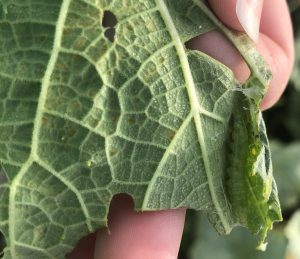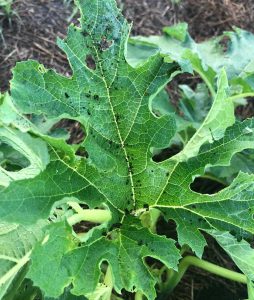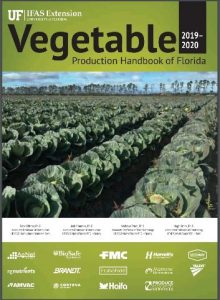Fall is just around the corner and one thing people always associate with fall are pumpkins! Different types of pumpkins and squash are used for decorations and made into desserts. Vegetables such as these are planted in the summer month to reach the buying times in October. Unfortunately, the summer months and early fall are prime times for pest and disease to affect squash crops. One pest we have seen in Suwannee County farmers’ squash fields recently are melonworms. Read on to find out more about melonworms!
What are melonworms?

Melonworms are commonly found throughout the year in southern Florida, depending on the availability of host plants. In north Florida, melonworms will arrive in the summer months around June and can negatively impact crops. They will complete their life cycle in about 30 days from egg to adult. Melonworm moths lay on average 2-6 oval white/green eggs in small clusters. After 3-4 days, the eggs will hatch into larva, where they will go through five instars. Larvae will develop in 14 days and after that time, will enter pupal stage where they will be in for 9-10 days. After, the melonworm will enter the adult moth stage. Moths are about 2.5 cm in length and are white in color with dark brown edges.

Identification:
Melonworm larvae is what you will usually find in your crop when you are scouting for pests. They are green worms with two white stripes running along their bodies and one darker thin line between the two seen above. When they look like this, melonworms are usually in their fifth instar. You may find folded leaves within your field and if you look inside that folded leaf, you will find a loose silk structure that the melonworm has constructed for shelter during the daylight hours.
Crop Damage:

Melonworms feed primarily on leaves and prefer summer or winter squash. If the leaves have all been eaten or are not desired, they will resort to feeding on the surface of the fruit, leaving scars, or burrow into the fruit. Melonworm damage can potentially cause yield loss. Make sure to scout your field to identify if melonworms are in your field. You may also find small, circular poop on the leaves, which is a good indicator there may be a population within the field.
Cultural Control:
- Planting a trap crop on the edges of the field
- Intercropping with your squash crop
- Clean-up field after harvest and destroy any residue containing melonworm
Chemical Control:

Insecticides work very well on controlling melonworm populations since they are a common pest on vegetable crops. Check out the Vegetable Production Handbook of Florida for proper management practices. If insecticides are applied, remember to spray when the wind is low and when there is low pollinator population in the field, usually early in the morning or late at night. Always remember to read the label before applying any chemicals in your field. THE LABEL IS THE LAW. If you have concerns of melonworm, feel free to call me at the UF/IFAS Suwannee County Extension Office, an Equal Opportunity Institution, for spray recommendations at 386-362-2771.
 0
0
